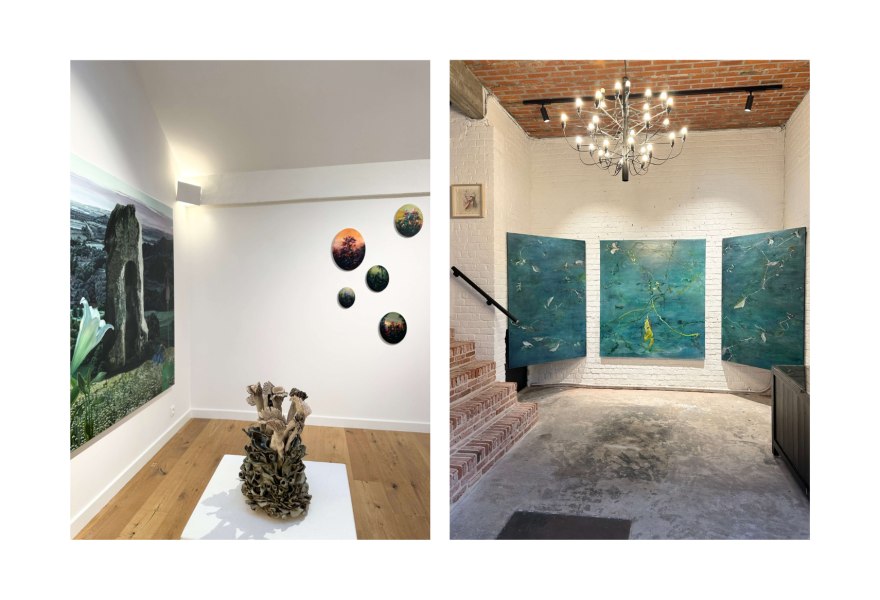24 january 2025, Yves Joris
A Rose Right on Target at TaLe Art Gallery
The scent of flowers fills the room — not as a fleeting perfume, but as a whisper of timeless stories. In the exhibition 'Rose is a Rose is a Rose' at TaLe Art Gallery, flowers are not merely presented as silent witnesses to beauty, but as carriers of meaning, as symbols that invite quiet reflection. Here, the artworks dance to the rhythm of Gertrude Stein’s words, a repetition that brings us back to the essence of language, of objects and of ourselves.
Stein's iconic line, first appearing in her poem Sacred Emily (1913), holds immense power: “A rose is a rose is a rose”. With these words, Stein dismantled the complexity of language, reminding us that objects retain their essence, despite the layers of meaning we, as viewers, impose on them. The strength of her language lies in its rhythmic simplicity and deep, almost hypnotic repetition, which challenges us to see beyond the superficial.

Marja Kennis, Z.t, Hybrid (Klein Rozet), 2021, TaLe Art Gallery
A layered garden
On entering the exhibition, you do not feel like a spectator, but rather a wanderer in a boundless garden. Joke Raes takes you into a world where organic forms transcend their natural origins. Her ceramic sculptures seem to be breathing, whispering tales of growth and decay, of revelation and concealment. Every curve, every detail calls for a moment of quiet contemplation, inviting you to rediscover the rhythm of nature.
Further on, you encounter the work of Marja Kennis, where ceramics and nature melt into one. Her artifacts are not mere objects, but frozen moments—a deliberate attempt to preserve the ephemeral in something lasting. She reminds us how we, as humans, constantly try to hold onto the ungraspable. Every leaf, every bud echoes Stein’s paradoxical simplicity: a rose is a rose is a rose, yet it is so much more.
Romance and irony
Thibo Moreels introduces another atmosphere to this floral abundance. His paintings and sculptures exude a nostalgic romanticism paired with playful Biedermeier irony. In his work, the tension between the mundane and the sublime is palpable. His playful pieces under glass domes sharply contrast with the dark floral abundance on oval panels. But my attention was particularly drawn to his work where he meticulously wraps threads around objects, creating an almost voyeuristic effect—like peering through open blinds at the world outside.

Rose is a Rose is a Rose, TaLe Art Gallery
The ethereal and the introspective
Mireille Robbe in turn captivates us with her almost weightless creations. She crafts solitary roses untouched by time, blurring the boundaries between reality and imagination. Her work is like quiet poems, composed of natural materials that carry their own histories. Yet her creations also reveal a profound botanical knowledge and eye for detail. The fragility of her compositions reflects the human condition itself—always searching, always in dialogue with the invisible.
Stéphanie Leblon adds another dimension with her layered paintings in which light and texture engage in a delicate dance. As always, she starts with a selfie, her pixel muse who inspires her work. Her pieces are both physical and ethereal—an interplay between abstraction and narrative. The flowers she depicts are not simple blooms, but symbols of something greater, something elusive. They invite us not only to look but to feel, to experience the depth of their layers as echoes of our own experiences.
Space as metaphor
Jonas Vansteenkiste takes on a dual role in this exhibition, serving as both artist and curator, successfully weaving together these diverse voices into a harmonious whole. His conceptual installations and vision of space add an extra layer to the exhibition. To Vansteenkiste, the exhibition space is not a neutral stage, but a home in which artworks interact with each other and their surroundings. Here, the space itself transforms into a metaphor, a living organism where stories grow and bloom.
His focus on architecture and transformation turns this exhibition into an experience that is not only visual but intellectual. He invites us to consider how art not only reflects something, but also shapes it—how it influences space and enriches our understanding of the world.

Jonas Vansteenkiste, Victoria May Thatcher, 2019, TaLe Art Gallery
An encounter with the indescribable
What makes 'Rose is a Rose is a Rose' so powerful is how it confronts us with the indescribable. Every artwork in this exhibition attempts to capture something that cannot truly be captured—the essence of a flower, a moment, a thought. It is an invitation to look again, to listen again and to feel again.
The artists do not present us with answers, but with questions. With their fleeting beauty, how can flowers carry so much meaning? Gertrude Stein’s words resonate throughout the exhibition like a subtle melody that binds everything together. Her repetition, her focus on the rhythm of language, is translated here into a visual rhythm. The flowers in this exhibition are not merely flowers, but symbols, floral metaphors, carriers of memories and dreams. They remind us that art — like language — is always in motion, always undergoing transformation.
In the lush metaphorical garden of 'Rose is a Rose is a Rose', we encounter not only the works of art, but also ourselves. We are challenged to look beyond superficial beauty, to discover the depth and layers hidden in each piece. It is an experience that is both aesthetically and intellectually enriching—a celebration of art’s ability to connect us with what is essential.
As you leave the exhibition, you are left with a sense of wonder. The flowers, the sculptures, the paintings — they are all a rose, and yet so much more. Stein’s words, and the artworks inspired by them, linger like a soft whisper that carries you into your own story. For just as a rose continues to bloom, so too does art continue to inspire, challenge and enchant us.
